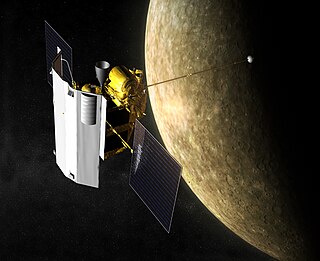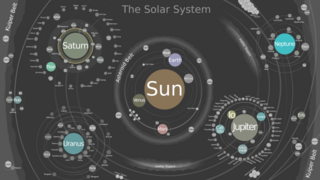Related Research Articles

Mercury is the first planet from the Sun and the smallest in the Solar System. It is a terrestrial planet with a heavily cratered surface due to overlapping impact events. These features are well preserved since the planet has no geological activity and an extremely tenuous atmosphere called an exosphere. Despite being the smallest planet in the Solar System with a mean diameter of 4,880 km (3,030 mi), 38% of that of Earth, Mercury is dense enough to have roughly the same surface gravity as Mars. Mercury has a dynamic magnetic field with a strength about 1% of that of Earth's and has no natural satellites.

Space exploration is the use of astronomy and space technology to explore outer space. While the exploration of space is currently carried out mainly by astronomers with telescopes, its physical exploration is conducted both by uncrewed robotic space probes and human spaceflight. Space exploration, like its classical form astronomy, is one of the main sources for space science.

A gravity assist, gravity assist maneuver, swing-by, or generally a gravitational slingshot in orbital mechanics, is a type of spaceflight flyby which makes use of the relative movement and gravity of a planet or other astronomical object to alter the path and speed of a spacecraft, typically to save propellant and reduce expense.

MESSENGER was a NASA robotic space probe that orbited the planet Mercury between 2011 and 2015, studying Mercury's chemical composition, geology, and magnetic field. The name is a backronym for "Mercury Surface, Space Environment, Geochemistry, and Ranging", and a reference to the messenger god Mercury from Roman mythology.

BepiColombo is a joint mission of the European Space Agency (ESA) and the Japan Aerospace Exploration Agency (JAXA) to the planet Mercury. The mission comprises two satellites launched together: the Mercury Planetary Orbiter (MPO) and Mio. The mission will perform a comprehensive study of Mercury, including characterization of its magnetic field, magnetosphere, and both interior and surface structure. It was launched on an Ariane 5 rocket on 20 October 2018 at 01:45 UTC, with an arrival at Mercury planned for on 5 December 2025, after a flyby of Earth, two flybys of Venus, and six flybys of Mercury. The mission was approved in November 2009, after years in proposal and planning as part of the European Space Agency's Horizon 2000+ programme; it is the last mission of the programme to be launched.
Giuseppe "Bepi" Colombo was an Italian scientist, mathematician and engineer at the University of Padua, Italy.

The geology of Mercury is the scientific study of the surface, crust, and interior of the planet Mercury. It emphasizes the composition, structure, history, and physical processes that shape the planet. It is analogous to the field of terrestrial geology. In planetary science, the term geology is used in its broadest sense to mean the study of the solid parts of planets and moons. The term incorporates aspects of geophysics, geochemistry, mineralogy, geodesy, and cartography.

Observations of the planet Venus include those in antiquity, telescopic observations, and from visiting spacecraft. Spacecraft have performed various flybys, orbits, and landings on Venus, including balloon probes that floated in the atmosphere of Venus. Study of the planet is aided by its relatively close proximity to the Earth, compared to other planets, but the surface of Venus is obscured by an atmosphere opaque to visible light.

The exploration of Mercury has a minor role in the space interests of the world. It is the least explored inner planet. As of 2015, the Mariner 10 and MESSENGER missions have been the only missions that have made close observations of Mercury. MESSENGER made three flybys before entering orbit around Mercury. A third mission to Mercury, BepiColombo, a joint mission between the Japan Aerospace Exploration Agency (JAXA) and the European Space Agency, is to include two probes. MESSENGER and BepiColombo are intended to gather complementary data to help scientists understand many of the mysteries discovered by Mariner 10's flybys.

Mercury, being the closest to the Sun, with a weak magnetic field and the smallest mass of the recognized terrestrial planets, has a very tenuous and highly variable atmosphere containing hydrogen, helium, oxygen, sodium, calcium, potassium and water vapor, with a combined pressure level of about 10−14 bar. The exospheric species originate either from the Solar wind or from the planetary crust. Solar light pushes the atmospheric gases away from the Sun, creating a comet-like tail behind the planet.

The following outline is provided as an overview of and topical guide to the Solar System:
The following outline is provided as an overview of and topical guide to the Moon:
The following outline is provided as an overview of and topical guide to Uranus:
The following outline is provided as an overview of and topical guide to Neptune:
The following outline is provided as an overview of and topical guide to Venus:
The following outline is provided as an overview of and topical guide to Mars:
The following outline is provided as an overview of and topical guide to Saturn:
The following outline is provided as an overview of and topical guide to Jupiter:
The following outline is provided as an overview of and topical guide to the planet Earth: